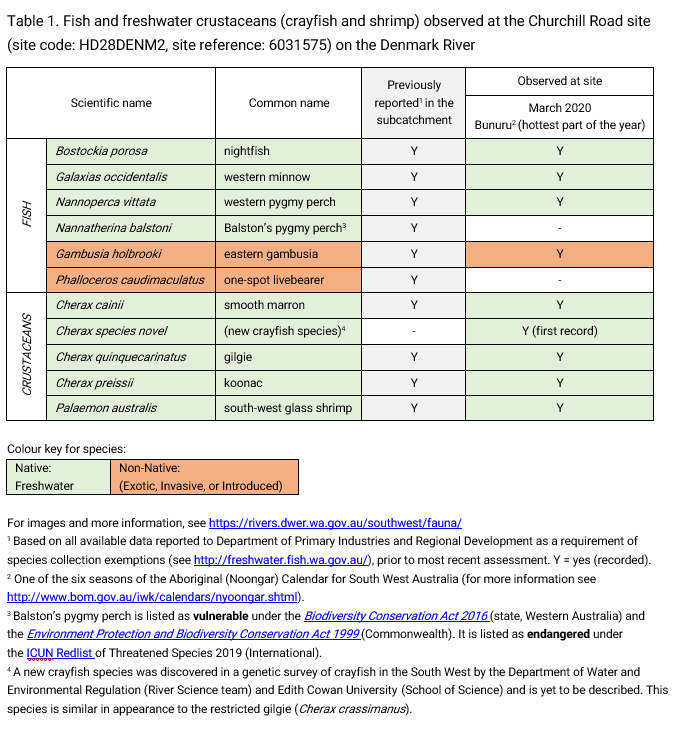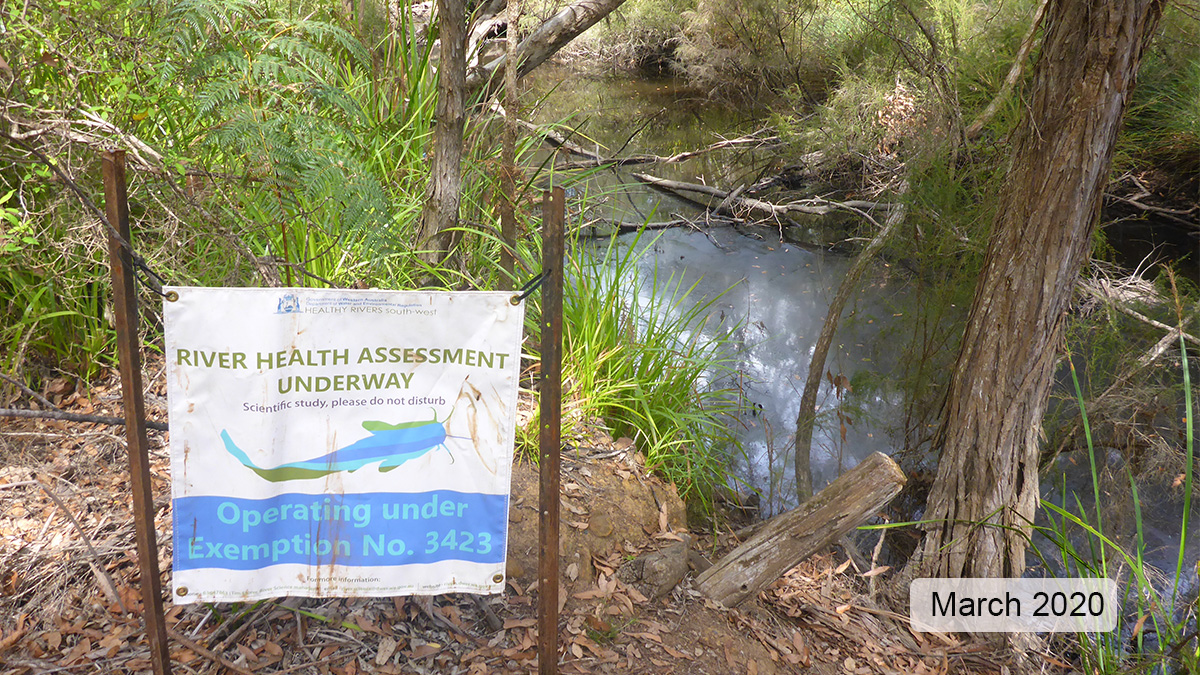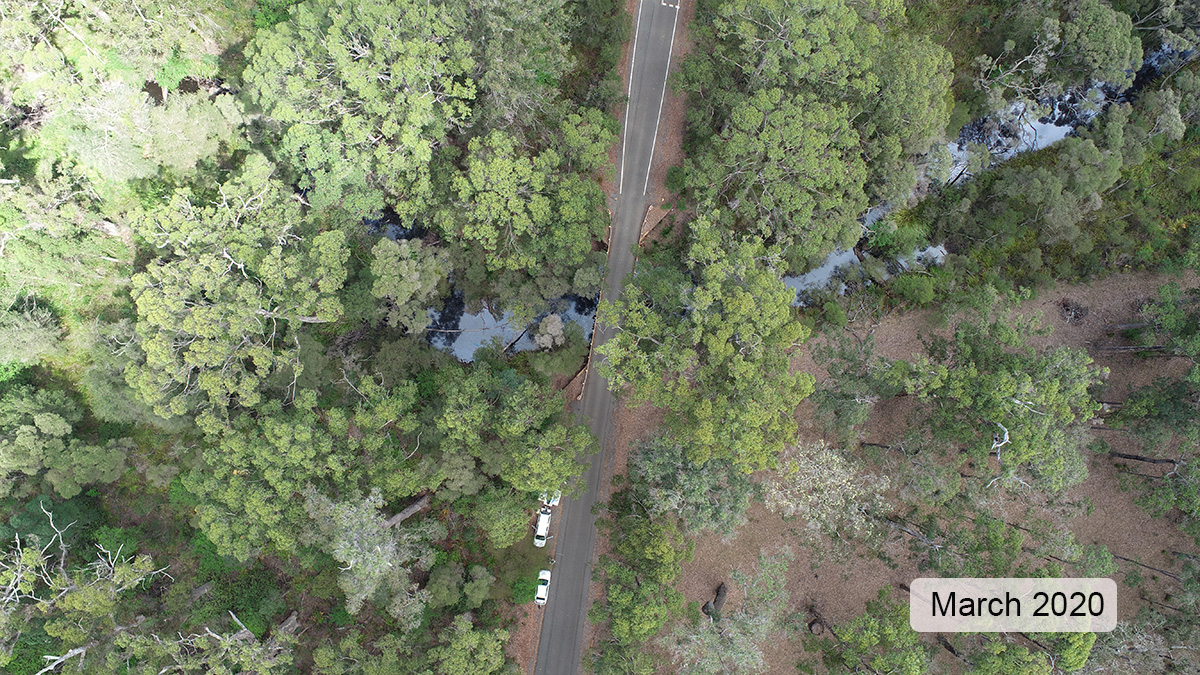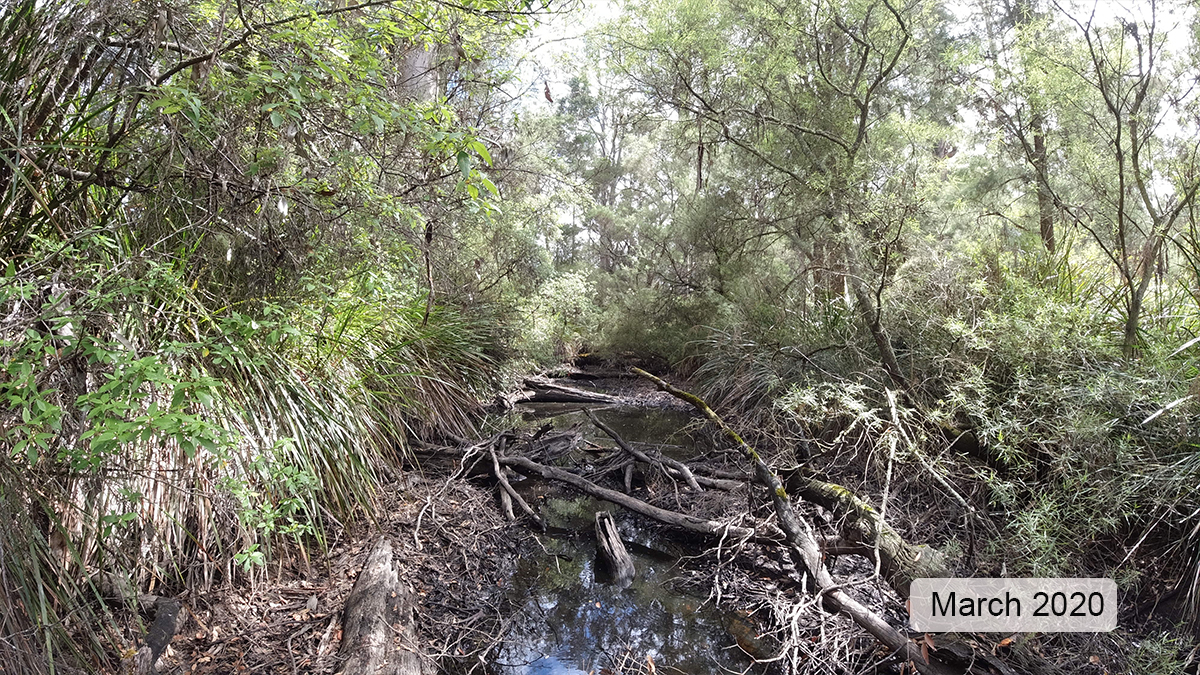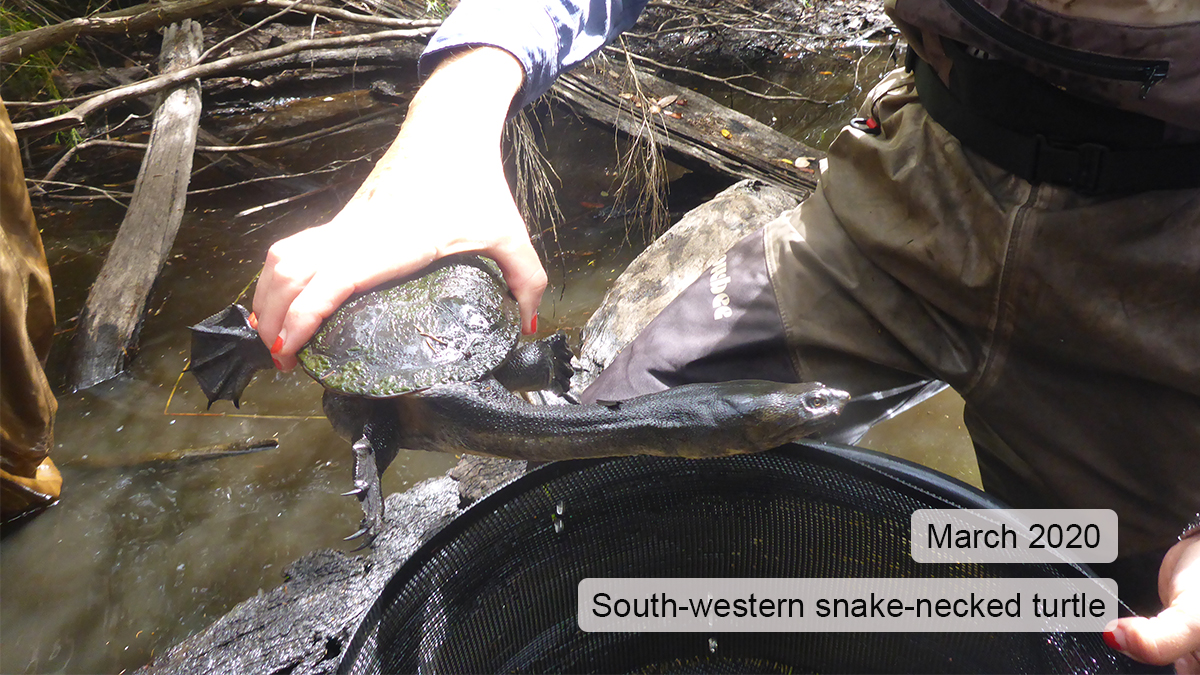
Denmark River - Churchill Road
Basin : Denmark Coast
Catchment : Hay - Denmark rivers
River condition at the Churchill Road site (site code: HD28DENM2, site reference: 6031575) on the Denmark River was assessed in March 2020 as part of the Healthy Rivers Program (Healthy Rivers), using standard methods from the South West Index of River Condition (SWIRC). The SWIRC incorporates field and desktop data from the site and from the broader catchment. Field data collected include the following indicators, assessed over approximately a 100 m length of stream:
- Aquatic biota: fish and crayfish community information (abundance of native and exotic species across size classes, general reproductive and physical condition) and macroinvertebrates
- Water quality: dissolved oxygen, temperature, specific conductivity, and pH (logged in-situ over 24 hours), as well as laboratory samples for colour, alkalinity, turbidity and nutrients
- Aquatic habitat: e.g. water depth, substrate type, presence of woody debris and detritus, type and cover of macrophytes and draping vegetation
- Physical form: channel morphology, bank slope and shape, bioconnectivity (barriers to migration of aquatic species), erosion and sedimentation
- Fringing zone: width and length of vegetation cover within the river corridor and lands immediately adjacent, structural intactness of riparian and streamside vegetation
- Hydrology: measures of flow (velocity) at representative locations (compared against data from stream gauging stations within the system)
- Local land use: descriptions of local land use types and activities (compared against land use mapping information for the catchment)
This is the first assessment of this site using the SWIRC methods. Previous assessments of river ecology have occurred at this location by Department of Fisheries and Murdoch University.
Assessments are listed below:
- 2020 – summer (16–17 March): Healthy Rivers
- 2011 – spring (November): Department of Fisheries (this study was focused on marron stocks)
- 2007 – spring (November): Murdoch University - Centre for Fish and Fisheries Research
Other department data: The river health site is approximately 4.8 km downstream of the departments Mt Lindesay flow gauging station (site reference: 603136), which has been in operation since 1960.
Search on the site code or site reference in the Department of Water and Environmental Regulation’s Water Information Reporting (WIR) system to find data for this site and nearby sampling points (flows, surface water quality, groundwater monitoring, the department's meteorological data). See also the Bureau of Meteorology website for additional meteorological data for the area.
Condition summary
A complete condition summary for this site has not yet been published. Please contact the department’s River Science team for site data (please provide the site code and sampling dates).
The image below indicates conditions at the time of sampling in March, towards the end of the dry season. March is within the Noongar season of Bunuru, which is generally the driest and hottest part of the year. Further images are provided in the gallery at the bottom of the page to show general site conditions.
An overview of aquatic species found at the site is provided in the next section.
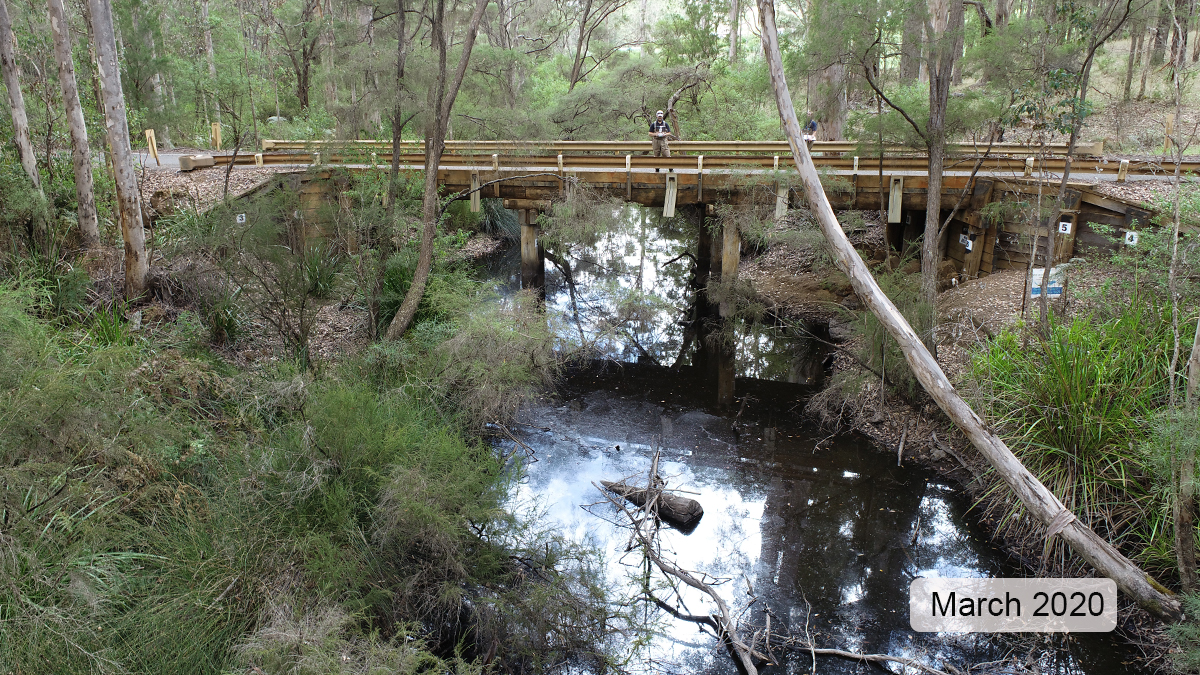
Species found in subcatchment
Native Species
- Balston's pygmy perchNannatherina balstoni
- Cherax species novel (new crayfish species)
- GilgieCherax quinquecarinatus
- KoonacCherax preissii
- NightfishBostockia porosa
- Smooth marronCherax cainii
- South-west glass shrimpPalaemon australis
- South-western snake-necked turtleChelodina colliei
- Western minnowGalaxias occidentalis
- Western pygmy perchNannoperca vittata
Exotic Species
Species found at the site
Fish and crayfish
Nine species were recorded at this site in the March 2020 assessments. This includes three native fish (nightfish, western minnow, western pygmy perch), five native crustaceans (smooth marron, gilgie, koonac, a new crayfish species (see below for further information) and south-west glass shrimp), and one non-native fish (eastern gambusia).
The invasive eastern gambusia were in particularly high abundance at this site and made up approximately 70 percent of the catch.
The new crayfish species recorded at this site was discovered through a genetic survey of crayfish in South West Western Australia undertaken by the department and Edith Cowan University (School of Science) in 2019–2020. This crayfish was recorded across the Denmark-Albany region and is similar in appearance to the restricted gilgie (Cherax crassimanus). This new species of crayfish is yet to be described, for the purpose of this summary it will be referred to as Cherax species novel.
Two fish species previously found in the subcatchment were not recorded in this assessment, these were the native Balston’s pygmy perch, and the invasive one-spot livebearer fish.
Balston’s pygmy perch is listed as vulnerable under the Biodiversity Conservation Act 2016 (Western Australia). It was previously recorded further upstream in the catchment in 2008 (Close et. al. 2008), and although it was not recorded in this assessment it may be present elsewhere in the catchment.
The invasive one-spot livebearer fish was previously recorded further downstream in the Denmark Dam in 2015 (Ryan et al. 2015) in very low abundance, however this is the first known record of this pest species in the catchment.
Only fish and freshwater crustaceans (crayfish and shrimp) that typically inhabit river channels are targeted by the standard SWIRC sampling methods. However, where other species were caught and/or observed (e.g., turtles, rakali-native water rats, tadpoles), these are mentioned below in the Other aquatic fauna section.
Note: collection of fauna from inland aquatic ecosystems across Western Australia requires a license from the Department of Primary Industries and Regional Development (DPIRD) and also the Department of Biodiversity, Conservation and Attractions (DBCA). All species collected must be reported to these agencies as part of license conditions.
Aquatic macroinvertebrates
Macroinvertebrate sampling occurred during the March 2020 assessments. Please contact the department’s River Science team for site data (please provide the site code and sampling dates).
Other aquatic fauna
Although not targeted by collection methods a south-western snake-necked turtle (Chelodina colliei) was recorded during March 2020 assessments.
For more information on aquatic species, please see the River Science fauna page here.
References & recommended reading
Explore other sites in the catchment
- Cleerilliup Creek - Bevan Road
- Denmark River - Amarilup Road
- Denmark River - Granite Road
- Denmark River - Howe Road
- Denmark River - Riverbend Lane
- Denmark River - Settlers Road
- Hay River
- Hay River - Historical Weir Ruin
- Mitchell River - Denmark Mt Barker Road
- Quickup River - Powleys Road
- Sheepwash Creek
- Sleeman Creek
